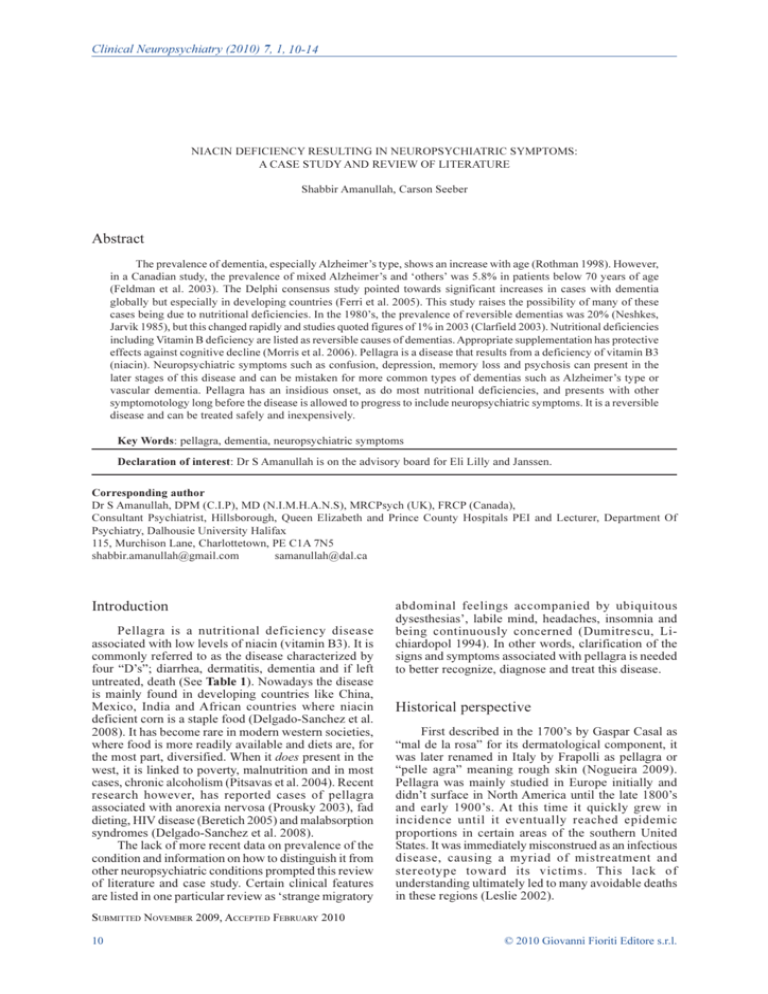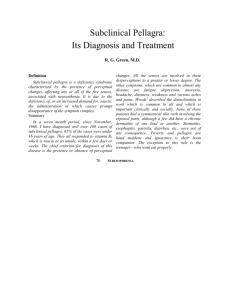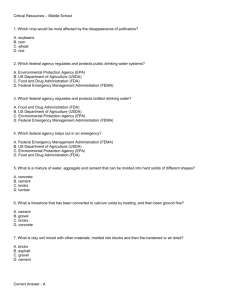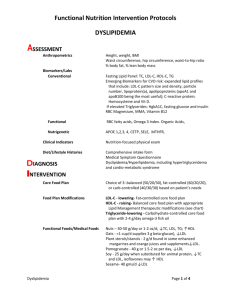niacin deficiency resulting in neuropsychiatric symptoms
advertisement

Clinical Neuropsychiatry (2010) 7, 1, 10-14 NIACIN DEFICIENCY RESULTING IN NEUROPSYCHIATRIC SYMPTOMS: A CASE STUDY AND REVIEW OF LITERATURE Shabbir Amanullah, Carson Seeber Abstract The prevalence of dementia, especially Alzheimers type, shows an increase with age (Rothman 1998). However, in a Canadian study, the prevalence of mixed Alzheimers and others was 5.8% in patients below 70 years of age (Feldman et al. 2003). The Delphi consensus study pointed towards significant increases in cases with dementia globally but especially in developing countries (Ferri et al. 2005). This study raises the possibility of many of these cases being due to nutritional deficiencies. In the 1980s, the prevalence of reversible dementias was 20% (Neshkes, Jarvik 1985), but this changed rapidly and studies quoted figures of 1% in 2003 (Clarfield 2003). Nutritional deficiencies including Vitamin B deficiency are listed as reversible causes of dementias. Appropriate supplementation has protective effects against cognitive decline (Morris et al. 2006). Pellagra is a disease that results from a deficiency of vitamin B3 (niacin). Neuropsychiatric symptoms such as confusion, depression, memory loss and psychosis can present in the later stages of this disease and can be mistaken for more common types of dementias such as Alzheimers type or vascular dementia. Pellagra has an insidious onset, as do most nutritional deficiencies, and presents with other symptomotology long before the disease is allowed to progress to include neuropsychiatric symptoms. It is a reversible disease and can be treated safely and inexpensively. Key Words: pellagra, dementia, neuropsychiatric symptoms Declaration of interest: Dr S Amanullah is on the advisory board for Eli Lilly and Janssen. Corresponding author Dr S Amanullah, DPM (C.I.P), MD (N.I.M.H.A.N.S), MRCPsych (UK), FRCP (Canada), Consultant Psychiatrist, Hillsborough, Queen Elizabeth and Prince County Hospitals PEI and Lecturer, Department Of Psychiatry, Dalhousie University Halifax 115, Murchison Lane, Charlottetown, PE C1A 7N5 shabbir.amanullah@gmail.com samanullah@dal.ca Introduction Pellagra is a nutritional deficiency disease associated with low levels of niacin (vitamin B3). It is commonly referred to as the disease characterized by four Ds; diarrhea, dermatitis, dementia and if left untreated, death (See Table 1). Nowadays the disease is mainly found in developing countries like China, Mexico, India and African countries where niacin deficient corn is a staple food (Delgado-Sanchez et al. 2008). It has become rare in modern western societies, where food is more readily available and diets are, for the most part, diversified. When it does present in the west, it is linked to poverty, malnutrition and in most cases, chronic alcoholism (Pitsavas et al. 2004). Recent research however, has reported cases of pellagra associated with anorexia nervosa (Prousky 2003), fad dieting, HIV disease (Beretich 2005) and malabsorption syndromes (Delgado-Sanchez et al. 2008). The lack of more recent data on prevalence of the condition and information on how to distinguish it from other neuropsychiatric conditions prompted this review of literature and case study. Certain clinical features are listed in one particular review as strange migratory abdominal feelings accompanied by ubiquitous dysesthesias, labile mind, headaches, insomnia and being continuously concerned (Dumitrescu, Lichiardopol 1994). In other words, clarification of the signs and symptoms associated with pellagra is needed to better recognize, diagnose and treat this disease. Historical perspective First described in the 1700s by Gaspar Casal as mal de la rosa for its dermatological component, it was later renamed in Italy by Frapolli as pellagra or pelle agra meaning rough skin (Nogueira 2009). Pellagra was mainly studied in Europe initially and didnt surface in North America until the late 1800s and early 1900s. At this time it quickly grew in incidence until it eventually reached epidemic proportions in certain areas of the southern United States. It was immediately misconstrued as an infectious disease, causing a myriad of mistreatment and stereotype toward its victims. This lack of understanding ultimately led to many avoidable deaths in these regions (Leslie 2002). SUBMITTED NOVEMBER 2009, ACCEPTED FEBRUARY 2010 10 © 2010 Giovanni Fioriti Editore s.r.l. Niacin deficiency resulting in neuropsychiatric symptoms Table 1. Clinical Presentation of Pellagra (the Ds) 'HUPDWLWLV 'LDUUKHD 'HPHQWLD 'HDWK 2IWHQWKHLQLWLDO SUHVHQWDWLRQ 6XQEXUQOLNHUDVKRYHUVXQH[SRVHGDUHDV 3URJUHVVHVWRDGU\GDUNDQGVFDO\OHVLRQ 2QHSDUWLFXODUVNLQOHVLRQHQFRPSDVVHVWKH QHFNDQGLVUHIHUUHGWRDV³&DVDO¶VQHFNODFH´ DIWHUWKHILUVWSK\VLFLDQWRGHVFULEHSHOODJUD &DQDOVREHWKHLQLWLDO 3DWLHQWZLOOW\SLFDOO\H[SHULHQFHDEGRPLQDO SUHVHQWDWLRQ SDLQDQGYRPLWLQJIROORZHGE\ZDWHU\ GLDUUKHDWKDWEHFRPHVFKURQLFLIQRWWUHDWHG 8VXDOO\SUHVHQWVODVW 3DWLHQWFDQSUHVHQWZLWKFRQIXVLRQ DQGLVTXLWHYDULHG GLVRULHQWDWLRQVHL]XUHVKDOOXFLQDWLRQV SV\FKRVLVFRQIXVLRQPHPRU\ORVVDSDWK\ DJJUHVVLRQLQVRPQLDDQGRUGHSUHVVLRQ 8QWUHDWHGSDWLHQWVFDQGLHIURP3HOODJUDZLWKLQ\HDUVRILQLWLDO SUHVHQWDWLRQ The etiology of pellagra continued to be debated until 1926, when Joseph Goldberger was able to clarify the role of nutrition as a cause of the disease and ultimately, a cure. Specifically, Goldberger discovered from studies carried out in hospitals and asylums in South Carolina, that although there were many patients with pellagra in these institutions, not one staff member ever developed the disease. When comparing these two populations, he found the most obvious differences to be dietary. He reasoned that the disease was most commonly associated with poverty and rural areas, strengthening his theory that there might be a dietary cure (Goldberger 1975). In 1947, it was found that tryptophan, an essential amino acid and a precursor to niacin, could be used to cure or prevent pellagra (Bender 1999). In the 1950s, studies were able to demonstrate that 60mg of tryptophan was equated to 1 mg of niacin (Bates 1999). In the end, it was determined that the best way to treat or prevent pellagra was the administration of preformed niacin. With this new information, physicians were able to demonstrate rapid patient response to niacin treatment and full reversal of the symptoms associated with the disease. Role of niacin in the body Niacin is obtained directly from food or synthesized from an essential amino acid called tryptophan. The synthesis of niacin from tryptophan involves B2 and B6, two other B vitamins, which act as coenzymes. Nicotinamide and nicotinic acid are two forms of niacin which are components of coenzymes nicotinamide adenine dinucleotide (NAD) and nicotinamide adenine dinucleotide phosphate (NADP). Clinical Neuropsychiatry (2010) 7, 1 These coenzymes are involved in essential oxidationreduction reactions in the body. It helps to explain why body tissues with high energy requirements (brain) or high turnover rates (skin, gut) tend to be primarily affected in pellagra (Ishii and Nishihara 1981). Secondary causes of pellagra Secondary causes of niacin deficiency and pellagra include metabolic diseases such as Hartnups disease, Carcinoid syndrome and treatment with antituberculosis medications (isoniazid and pyrazinamide) (Delgado-Sanchez et al. 2008) (See Table 2). In each case, there is some limitation to the absorption or metabolism of niacin or tryptophan. One of the side effects of anti-tuberculosis medication (isoniazid) is that it tends to corral vitamin B6 resulting in a decrease in niacin synthesis in the body. In patients with carcinoid syndrome, patients develop neuroendocrine tumors along the GI tract. These tumors use up body stores of tryptophan to form serotonin. This indirectly results in niacin deficiency because tryptophan, a precursor for niacin, is taken away from its synthesis. In the case of Hartnups disease, niacin deficiency occurs due to a decrease in tryptophan and/or niacin absorption in the gut. Diagnosing pellagra The diagnosis of pellagra is clinical. Although not equivocal evidence of pellagra, a fluorometric assay of urinary metabolites (2-pyridone/N-methylniacinamide ration less than 2.0) can be ordered to show niacin deficiency (Das 2006). Patients can also be tested for 11 Shabbir Amanullah, Carson Seeber Table 2. Secondary causes of niacin deficiency which can result in pellagra +DUWQXS¶V'LVHDVH &DUFLQRLG6\QGURPH WU\SWRSKDQDEVRUSWLRQ WU\SWRSKDQ PHWDEROLVP $QWL7XEHUFXORVLV FRQYHUVLRQRI PHGLFDWLRQLVRQLD]LG WU\SWRSKDQWRQLDFLQ S\UD]LQDPLGH $5PHWDEROLFGLVRUGHUWKDWLQWHUIHUHVZLWK LQWHVWLQDODEVRUSWLRQRIQHXWUDODPLQRDFLGV LQSDUWLFXODUWU\SWRSKDQ $FDUFLQRLGWXPRULVDQHXURHQGRFULQH WXPRUWKDWJURZVDORQJWKH*,WUDFWPRVW FRPPRQO\DIIHFWLQJWKHDSSHQGL[LOHXPRU UHFWXP7KHVHWXPRUVV\QWKHVL]HDQG VHFUHWHVHURWRQLQ+7D QHXURWUDQVPLWWHUIRUPHGIURPWU\SWRSKDQ 7U\SWRSKDQOHYHOVDUHWKHUHIRUHGHSOHWHG WDNHQDZD\IURPWKHIRUPDWLRQRIQLDFLQ ,VRQLD]LGLVDQHXURWR[LFGUXJXVHGLQD UHJLPHQWIRUWXEHUFXORVLVWUHDWPHQW,W LQKLELWVWKHV\QWKHVLVRIP\FROLFDFLGVD FRPSRQHQWRIFHOOZDOOVRQWKH7% EDFWHULXP,QWKHSURFHVVLWGHSOHWHV YLWDPLQ%ZKLFKLVDFRHQ]\PHLQWKH FRQYHUVLRQRIWU\SWRSKDQWRQLDFLQ 3DWLHQWVUHFHLYLQJWKLVGUXJDUHRIWHQ VXSSOHPHQWHGZLWKYLWDPLQ% blood levels of tryptophan, a precursor for niacin (Delgado-Sanchez et al. 2008). A confirmatory diagnosis is made when patients experience a rapid improvement in symptoms (over 5-7 days) when given large doses of niacin (50-500 mg/day) and/or a diet enriched in niacin (Prousky 2003, Nogueira 2009, Delgado-Sanchez et al. 2008). In most cases, once patients are treated with niacin, neuropsychiatric manifestations are relieved dramatically overnight followed by reversal of skin lesions and diarrhea (Das 2006). In some cases, complete resolution of dermatitis may take 3-4 weeks (Nogueira 2009). The ratio of NAD:NADP in erythrocytes is also purported to have some value in testing. Methodology The search strategy for this paper involved the use of a Medical Subject Heading (MeSH) search which was carried out using the Pub Med search engine. The following key words were used: Niacin deficiency AND Pellagra obtained 1139 articles of which 730 were in English. Many were not seen as relevant to the question. Addition of the term Niacin AND Neuropsychiatric symptoms obtained eight articles. Pellagra AND dementia reveled 30 articles. To address the issue of 12 patients with neuropsychiatric symptoms in the context of niacin deficiency, the articles referenced were carefully perused. A number of articles were in Japanese and German. Case report The patient is a 64 year old Caucasian female. She was brought to Emergency by her neighbor who found her unresponsive in her home. She expressed concern about the patients confusion, self neglect and an attempted overdose on over the counter sleeping pills. The patient was apparently living on a diet of cola and takeout food for a number of months and rarely cooked for herself. She denied alcohol use or abuse. There was reportedly food in the house but it was sparse and past the expiry date. Her home was covered in excrement which the patient stated was due to her chronic diarrhea. The in-home heat was apparently turned up to around 36 degrees Celsius as she claimed she was always cold. She had no features suggestive of hypothyroidism. On physical examination she was found to be confused, lacking insight and showed signs of depression. She had a beefy, furry and fissured tongue and scaly, erythematous skin lesions over her shins bilaterally. She had no acute metabolic issues on initial Clinical Neuropsychiatry (2010) 7, 1 Niacin deficiency resulting in neuropsychiatric symptoms Table 3. Pertinent lab values and findings RBC Hct MCV Ferritin AST ALT GGT Total Bili Sodium Potassium Chloride TSH Anion Gap CT Scan (4.50-6.20) (0.420-0.520) (80.0-100.0) (10-135) (5-35) (5-37) (7-32) (2.0-20.0) (135-145) (3.5-5.1) (96-109) (0.40-4.20) (4-12) 3.63 0.365 100.5 199 94 85 74 17.8 144 4.9 111 4.53 16 10^12/L L/L fl mcg/L mU/ml mU/ml mU/ml umol/L mmol/L mmol/L mmol/L mU/L umol/L Frontotemporal atrophy. No hemorrhage or tumors were noted. Mini Mental Status Examination (MMSE) Before: 20/30 After: 29/30 assessment. There was no toxicology screen done at or around the time of admission and the laboratory was not equipped to perform urinalysis testing for 2pyridone/N-methylniacinamide levels. Estimate of 2pyridone/N-methylniacinamide is not done in Canada. The patients pertinent lab values are listed in Table 3. Head CT revealed significant frontotemporal atrophy with no hemorrhage or space occupying lesions noted. When assessed by psychiatry, she scored 20/30 on Mini Mental State Examination (MMSE). She had deficits in short term recall, and planning. She had a significant past history of major depression and was on antidepressants. She was living on her own. It was not clear what medications she was on in the past and we were concerned about adherence with them. During her stay in hospital, her confusion gradually lifted and she became more coherent. Her diarrhea persisted but with decreased severity. The patient was later started on 50 mg of niacin daily and she quickly became oriented to person, place and time. Her speech improved and she was more communicative and scored 29/30 on her MMSE. Over the next 3-5 days, her diarrhea and skin lesions resolved completely. At one point, the patient had to have her niacin stopped due to facial flushing (a common side effect of this treatment) which she became quite concerned about. A multivitamin with niacin was then added. After two months in hospital, she was discharged home but became non-compliant with her medications. She experienced cognitive decline again with confusion. She had a fall at home and fractured her ankle while rushing to the toilet (due to her diarrhea). The patient was re-admitted and while in hospital, niacin treatment was started again. Once again, her symptoms improved but this time she was transferred to a residential care Clinical Neuropsychiatry (2010) 7, 1 setting as it was determined that she was unable to function safely at home. At discharge, her medications were modafanil 100 mg daily, citalopram 50mg PO daily, olanzapine 5 mg HS, zopiclone 7.5 mg HS, folic acid (1mg) and a multivitamin. Plans were to stop olanzapine and taper and stop zopiclone on follow up in four weeks. Discussion Although this case report highlights the neuropsychiatric symptoms, niacin deficiency resulting in pellagra, has varied symptomatology and progression. A rash or chronic diarrhea is likely to present long before neuropsychiatric symptoms. Therefore, gastroenterologists, dermatologists or general practitioners may be the first to witness early stages of niacin deficiency. The degree to which pellagra was allowed to progress in the patient is remarkable and may be explained by self neglecting behavior and a baseline frontotemporal dementia. Pellagra typically has an insidious onset suggesting there are many opportunities to pick up on the disease before it progresses to include neuropsychiatric symptoms in its later stages. A study published in 1981 states that in individuals with chronic alcoholism, presenting with certain gastrointestinal, neurological and mental status changes, pellagra should be suspected even if skin changes are absent (Ishii and Nishihara 1981). Another study suggested that in patients with chronic alcoholism who present with neuropsychiatric symptoms in the absence of gastrointestinal and dermatological changes should be worked up for pellagra (Teare et al. 1993). While confusion, depression, memory loss and insomnia can be seen in Alzheimers and vascular dementia, its association with diarrhea and skin changes point to a possible nutritional deficiency. The lack of diagnostic testing in some places due to its presumed low prevalence can make it difficult for clinicians. The patient in our case study had agreed on discharge to consider residential home accommodation if she could not manage at home on her own. She decided to return to her home and promptly relapsed due to non compliance. She was treated again and even though she responded well to treatment, it was apparent that her underlying frontotemporal dementia and impaired planning would lead to further relapses. This time she agreed to go into a residential care facility and has been doing very well ever since. Today, with the development of balanced nutrition and vitamin supplementation, modern diets account for daily requirements of niacin. Pellagra still exists however, and is a serious condition if left untreated. Deaths due to pellagra peaked in the United States in 1927 at around 7000 per year and then there was a rapid decline in cases over the next three decades due to fortification of grain products, availability of vitamin supplements and animal-derived foods along with improved treatment. By the 1950s there were close to zero pellagra related deaths per year (Park et al. 2000). We were unable to find any quantitative data on the prevalence of pellagra today but some literature suggests that pellagra is presenting more often in we- 13 Shabbir Amanullah, Carson Seeber stern society. A growing number of food faddists and patients living with HIV at least partially accounts for this (Delgado-Sanchez 2008). There may even be hope for the reversal of certain types of dementias or psychoses by way of dietary adjustments. Many studies including Cole et al. (1984) and Morris et al. (2006) have made links between B vitamins and mental health. Specifically, we know already that cyanocobalamine (B12), niacin (B3) and thiamine (B1) deficiencies are all linked to deterioration in mental state (Morris 2006, Cole and Prchal 1984). While there are no recent studies specifically looking at screening for pellagra and outcomes, one Canadian study looked at patients who were diagnosed with reversible dementias using a simplistic retrospective chart review. The study reported that only 3.6% of patients who fit these criteria actually demonstrated improvement with clinical intervention (Freter 1998). Perhaps this percentage will increase as we continue to understand the metabolic and nutritional correlation with mental health. Lastly, further research is necessary to look at the effectiveness of screening tests and the intervention outcomes in the clinical setting from a cost effectiveness model. Conclusion Although rare in western countries, there may be evidence to suggest an increase in cases of pellagra in the clinical setting (Delgado-Sanchez et al. 2008). Nutritional deficiencies, including vitamin B deficiencies, should be considered in the work-up of a patient who presents with dementia. A good history should be taken to rule out chronic alcoholism, malnourishment and/or general self-neglect. In any case, if pellagra is suspected, safe, inexpensive niacin, starting with low doses, can be administered with a very favorable risk/ benefit ratio for the patient. References Bates CJ (1999). Niacin. In Sadler MJ, Strain JJ, Ca Caballero B (eds) Encyclopedia of Human Nutrition. Academic Press, San Diego, CA, 1290-1298. Bender DA (1999). Pellagra. In Sadler MJ, Strain JJ, Ca Caballero B (eds) Encyclopedia of Human Nutrition. Academic Press, San Diego, CA, 1298-1302 Beretich Jr GR (2005). Do high leucine/low tryptophan dieting foods (yogurt, gelatin) with niacin supplementation cause neuropsychiatric symptoms (depression) but not dermatological symptoms of pellagra?. Medical Hypotheses 65, 3, 628-629. 14 Clarfield AM (2003). The decreasing prevalence of reversible dementias: an updated meta-analysis. Arch Int Med 163, 2219-29. Cole M, Prchal J. Low serum B12 in Alzheimers type dementia. Age Ageing, 1984; Mar. 13(2):101-5. Das R, Parajuli S, Gupta S (2006). Rash Imposition from a Lifestyle Omission: A Case Report of Pellagra. The Ulster Medical Journal 92-93. Delgado-Sanchez L, Godkar D, Niranjan S (2008). Pellagra: Rekindling of an Old Flame. American Journal of Therapeutics 15, 173-175. Dumitrescu C, Lichiardopol R (1994). Particular features of clinical pellagra. Rom J Intern Med 32, 2, 165-70. Feldman H, Levy AR, Hsiung GY et al. (2003). A Canadian cohort study of cognitive impairment and related dementias (ACCORD): study methods and baseline results. Neuroepidemiology 22, 265-74. Ferri CP, Prince M, Brayne C, Brodaty H, et al. (2005). A Delphi consensus study. Lancet 17, 366, 9503, 2112-7. Goldberger J (1975). The Etiology of Pellagra: The significance of certain epidemiological observations with respect thereto. Public Health Reports 90, 4, 373-375. Ishii N, Nishihara Y (1981). Pellagra among chronic alcoholics: clinical and pathological study of 20 necropsy cases. J Neurol Neurosurg Psychiatry 44, 209-215. Leslie C (2002). Fighting an Unseen Enemy: The Infectious Paradigm in the Conquest of Pellagra. Journal of Medical Humanities 23, ¾, 187-202. Morris M, Schneider J, Tangney C (2006). Thoughts on Bvitamins and dementia. Journal of Alzheimers Disease 9, 429-433. Neshkes RE, Jarvik LF (1985). The central nervous system dementia and delirium in old age. In Brocklehurst JC (ed) Textbook of Geriatric Medicine and Gerontology. Churchill Livingstone, Edinburgh, pp. 309-327. Nogueira A, Duarte A, Magina S, Azevedo F (2009). Pellagra associated with esophageal carcinoma and alcoholism. Dermatology Online Journal 15, 5, 8. Park K, Sempos C, Barton C, Vanderveen J, Yetley E (2000). Effectiveness of Food Fortification in the United States: The Case of Pellagra. American journal of Public Health 90, 5, 727-738. Pitsavas S, Andreou C, Bascialla F, Bozikas V, Karavatos A (2004). Pellagra Encephalopathy Following B-Complex Vitamin Treatment without Niacin. International Journal of Psychiatry in Medicine 34, 1, 91-95. Prousky J (2003). Pellagra May Be a Rare Secondary Complication of Anorexia Nervosa: A Systematic Review of the Literature. Alternative Medicine Review 8, 2, 180185. Rothman K, Greenland S (1998). Modern epidemiology. Lippincott-Raven, Philadelphia. Freter S, Bergman H, Gold S, Chertkow H and Clarfield AM (1998). Prevalence of potentially reversible dementias and actual reversibility in a memory clinic cohort. Canadian Medical Association Journal 159, 6, 657-662. Teare JP, et al. (1993). Acute encephalopathy due to coexistent nicotinic acid and thiamine deficiency. Br J Clin Pract 47, 6, 343-4. Clinical Neuropsychiatry (2010) 7, 1







